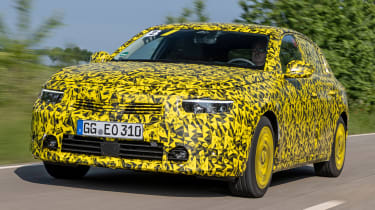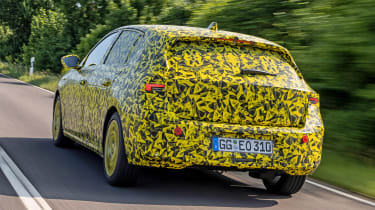A new Vauxhall Astra is on the way and we've driven a prototype ahead of its official arrival
Verdict
The all-new Astra shows real promise, especially in plug-in hybrid form with strong enough real-world range and the potential for low running costs, plus good performance and refinement. The new platform is loaded with tech and has brought a big boost to practicality, but initial impressions show it’s alo still fun to drive and has the potential to look and feel more premium than ever.
Vauxhall and European sister brand Opel are now part of the Stellantis empire, but as with the brands’ smaller Corsa model, for the all-new Vauxhall Astra it’s given the British firm access to a big toybox of tech to help develop the eighth generation of its family hatchback.
Underneath the bright yellow camouflage of our test car lies a much more premium look, with Vauxhall already having teased its new Vizor grille, new badging at the rear and an updated interior featuring its Pure Panel twin infotainment screen.
Best hatchbacks to buy 2021
It’s not visible in our pictures due to the prototype’s protective rubber matting on the dash, but Vauxhall has confirmed tech such as wireless Android Auto and Apple CarPlay will be standard.
New IntelliLux adaptive LED headlights with next-generation pixel tech feature too, with a striking running light signature visible despite the disguise.
More reviews
Car group tests
- Vauxhall Astra vs Ford Focus vs SEAT Leon
- Vauxhall Astra – best hatchbacks 2018
In-depth reviews
- Vauxhall Astra review
- Vauxhall Astra Sports Tourer review
- Vauxhall GTC review
Road tests
- New Vauxhall Astra 2019 review
Used car tests
- Used Vauxhall Astra review
There are plenty of advances underneath the newly styled panels too, because the Astra moves to the Stellantis Group’s third-generation EMP2 platform; 50 per cent of parts are new compared with the second generation of EMP2, showing just how much engineering effort has gone into the development of the Astra.
The platform incorporates the latest driver assistance systems to help boost safety, but also make the Astra more relaxing to drive, with semi-autonomous adaptive cruise with lane assist to feature, plus long-range blind spot detection, a 360-degree camera, rear cross traffic alert and more.
It’s also grown in size, offering more space to boost practicality and deliver what family hatchback buyers need. The Astra is just 4mm longer than its predecessor, but its wheelbase is 13mm greater meaning there’s more usable space inside, while boot volume stands at 422 litres. There’s an adjustable boot floor too, unlike its predecessor. A 54mm shorter front overhang and a 15mm lower roofline to help keep the centre of gravity lower boosts agility too, while a 51mm wider body and a 12mm lower seat height help it too feel sportier.
From launch there’ll be a choice of 1.2-litre three-cylinder turbocharged petrol engines, offering either 108bhp or 128bhp. Available with both six-speed manual and eight-speed automatic transmissions; it’s the second-generation of this Vauxhall unit, featuring high-pressure fuel injection. A 128bhp 1.5-litre with the same gearbox choices will be the only diesel available.
Bigger news for the Astra is that this will be the first generation of the car to be electrified, with two plug-in hybrid powertrains available. Both use a 1.6-litre turbocharged four-cylinder petrol engine combined with a 12.4kWh battery under the rear seats and a 108bhp electric motor, driving through an eight-speed automatic gearbox. There’ll be two outputs available, with either 178bhp or 222bhp. However, the latter choice won’t be available in the UK straight away.
The 128bhp 1.2 T we tried is a familiar unit, with a slightly grumbly soundtrack but plenty of torque and an acceptable gear shift from the six-speed manual. Its flexibility is its strong suit.
Refinement is improved in the 178bhp plug-in hybrid we tried, with the Astra rolling away silently and offering around 31 miles of all-electric range. The combustion engine only kicks in above town speeds when you ask for a burst of acceleration, while the electric motor’s assistance gives a solid slug of torque and a surprisingly sporty feel – maybe not quite to GSi levels, but it’s more than swift enough for a family hatchback.
The development cars we tested were more than 80 per cent completed, but have been built to validate engine and gearbox calibration, suspension tuning and refinement. On that latter point, with a laminated windscreen and thicker side windows the Astra is hushed on the move.
To help keep weight down Vauxhall is using high-tech materials such the latest thermoplastics, which are still highly rigid and also allow for the precise design details we know are lurking under our cars’ camo. Weight is also key to efficiency, and with low rolling resistance tyres as standard, plus other efficiency-improving tech, the Astra should offer competitive running costs.
But Vauxhall hasn’t lost its focus on the car being fun to drive. The brand is tuning the steering and suspension according to the model, with either single or dual-pinion electric power steering and different brake set-ups too.
The cars we tried were comfortable enough, with softer suspension than a Ford Focus, but firmer than the outgoing Peugeot 308, inspiring confidence and giving a predictable feel on the move.
The steering is precise as well, but too light – this is an area the engineers are working on, removing some assistance to give a better connection between car and driver. We can’t wait to try the final car later this year, with sales set to begin in October.
| Model: | Vauxhall Astra 1.6 T 180 PHEV e-EAT8 Auto |
| Price: | TBC |
| Engine: | 1.6-litre 4cyl petrol PHEV |
| Power: | 178bhp |
| Transmission: | Eight-speed automatic, front-wheel drive |
| 0-62mph: | TBC |
| Top speed: | TBC |
| EV range: | 31 miles (est.) |
| Charging: | 1hr 45 (est. 0-100% 7.4kW) |
| On sale: | October |
Next Steps
Source: Read Full Article


 Best hatchbacks to buy 2021
Best hatchbacks to buy 2021
